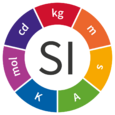2005–2019 definitions of the SI base units
From HandWiki
From 2005 to early 2019, the definitions of the SI base units were as follows:
| Name | Symbol | Measure | Pre-2019 (2005) formal definition[1] | Historical origin / justification | Dimension symbol |
|---|---|---|---|---|---|
| metre | m | length | "The metre is the length of the path travelled by light in vacuum during a time interval of 1 / 299792458 of a second." 17th CGPM (1983, Resolution 1, CR, 97) |
1 / 10000000 of the distance from the Earth's equator to the North Pole measured on the circumference through Paris. | L |
| kilogram | kg | mass | "The kilogram is the unit of mass; it is equal to the mass of the international prototype of the kilogram." 3rd CGPM (1901, CR, 70) |
The mass of one litre of water at the temperature of melting ice. A litre is one thousandth of a cubic metre. | M |
| second | s | time | "The second is the duration of 9192631770 periods of the radiation corresponding to the transition between the two hyperfine levels of the ground state of the caesium 133 atom." 13th CGPM (1967/68, Resolution 1; CR, 103) "This definition refers to a caesium atom at rest at a temperature of 0 K." (Added by CIPM in 1997) |
The day is divided in 24 hours, each hour divided in 60 minutes, each minute divided in 60 seconds. A second is 1 / (24 × 60 × 60) of the day. |
T |
| ampere | A | electric current | "The ampere is that constant current which, if maintained in two straight parallel conductors of infinite length, of negligible circular cross-section, and placed 1 metre apart in vacuum, would produce between these conductors a force equal to 2×10−7 newton per metre of length." 9th CGPM (1948) |
The original "Absolute Ampere" was defined as 0.1 Electromagnetic units. The original "International Ampere" was defined electrochemically as the current required to deposit 1.118 milligrams of silver per second from a solution of silver nitrate. Compared to the SI ampere, the difference is 0.015%. |
I |
| kelvin | K | thermodynamic temperature | "The kelvin, unit of thermodynamic temperature, is the fraction 1 / 273.16 of the thermodynamic temperature of the triple point of water." 13th CGPM (1967/68, Resolution 4; CR, 104) "This definition refers to water having the isotopic composition defined exactly by the following amount of substance ratios: 0.000 155 76 mole of 2H per mole of 1H, 0.000 379 9 mole of 17O per mole of 16O, and 0.002 005 2 mole of 18O per mole of 16O." (Added by CIPM in 2005) |
The Celsius scale: the Kelvin scale uses the degree Celsius for its unit increment, but is a thermodynamic scale (0 K is absolute zero). | Θ |
| mole | mol | amount of substance | "1. The mole is the amount of substance of a system which contains as many elementary entities as there are atoms in 0.012 kilogram of carbon 12; its symbol is 'mol'. 2. When the mole is used, the elementary entities must be specified and may be atoms, molecules, ions, electrons, other particles, or specified groups of such particles." 14th CGPM (1971, Resolution 3; CR, 78) "In this definition, it is understood that unbound atoms of carbon 12, at rest and in their ground state, are referred to." (Added by CIPM in 1980) |
Atomic weight or molecular weight divided by the molar mass constant, 1 g/mol. | N |
| candela | cd | luminous intensity | "The candela is the luminous intensity, in a given direction, of a source that emits monochromatic radiation of frequency 540×1012 hertz and that has a radiant intensity in that direction of 1 / 683 watt per steradian." 16th CGPM (1979, Resolution 3; CR, 100) |
The candlepower, which is based on the light emitted from a burning candle of standard properties. | J |
| Name | Symbol | Measure | Pre-2019 (2005) formal definition[1] | Historical origin / justification | Dimension symbol |
References


